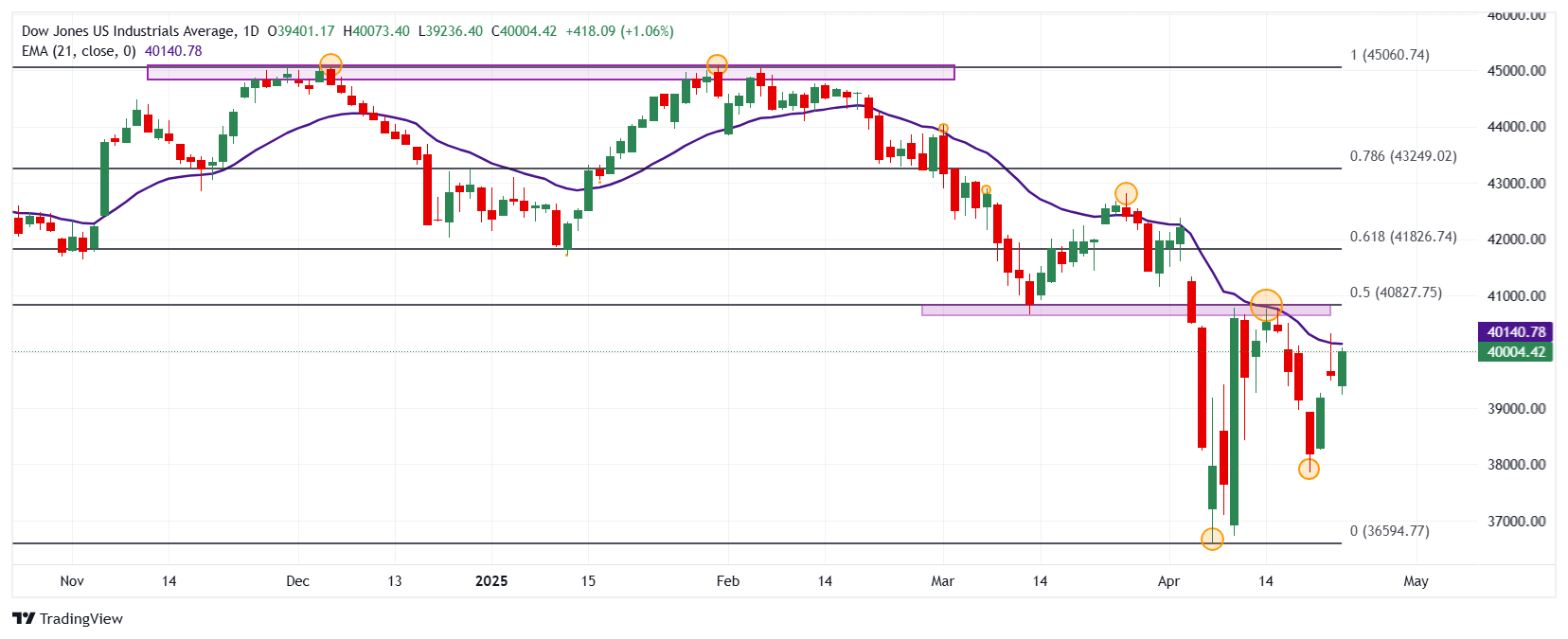- The Dow Jones advances 1.05% today, currently operating at 40.002.
- The Nasdaq 100 wins 2.21% in the day, consolidating at two -week maximums in 19,120.
- The S&P 500 rises 1.67% daily, led by Hasbro (HAS).
- Weekly applications for unemployment subsidy increased to 222,000 last week, exceeding analysts’ forecasts.
- Christopher Waller, a member of the FOMC, said that type cuts could come from an increase in unemployment.
The Dow Jones established a minimum of the day in 39,236, where buyers attracted the index to a daily maximum in 40,026.
The industrial average Dow Jones opened at 39,401, while the Nasdaq 100 technological index began operating in 18,664. The S&P 500 started the day in 5,359, extending the profits of the previous session.
The Dow Jones quote on the negative field promoted by Salesforce and Caterpillar
The Dow Jones index wins 1.05% daily, quoting currently over 40.002.
Salesforce (CRM) shares have a profit of 5.17% in the day, reaching maximum of April 9 at 264.08, spinning three consecutive sessions upwards, leading the profits in the Dow Jones.
On the other hand, the values of Caterpillar (CAT) earn 3.47% daily, visiting three -week maximums not seen since April 3 in 306.08 $.
The Dow Jones wins 375 points in the middle of the American session, taking up the upward perspective in tune with the main share rates.
Microchip technology and on semiconductor keep Nasdaq 100 in a profit zone
The Nasdaq 100 technological index rises 2.21% on Thursday, reaching maximums not seen since April 9 in 19,157.
Microchip Technology (MCHP) shares are fired 12.19% in the day, visiting April 3 at $ 47,15, signing its fifth consecutive day upwards.
In the same tonic, on semiconductor titles, recover 8.87% daily, operating at the time of writing at $ 39,87, reaching maximums of April 2.
The Nasdaq 100 wins 448 points today, currently quoting in 19,127, spinning three consecutive sessions with profits.
The S&P 500 reaches maximum two weeks animated by Hasbro
The S&P 500 wins 1.67%, visiting two -week maximums not seen from April 9 in 5,473.
According to the United States Department of Labor, weekly applications for unemployment subsidy increased to 222,000 in the week ending on April 19. This figure is located above the 216,000 observed in the previous week and the 221,000 estimated by the consensus.
At the same time, the requests for lasting goods increased by 9.2% in March compared to the planned 2%, exceeding 0.9% reported in February.
On the other hand, Christopher Waller, a member of the Board of Governors of the Federal Reserve, acknowledged in an interview today that rates cuts could come from the increase in unemployment, reiterating that the monetary authority will be attentive to the data to determine the future movements of the policy.
The S&P 500 goes up 95 points after this news, spinning three consecutive days upward. In this sense, Hasbro’s shares (HAS) shoot 14.52% on Thursday, operating at the time of writing about $ 60.34. This rebound is presented after making its quarterly report known, overcoming the expectations of analysts.
Technical Analysis of Dow Jones
The Dow Jones reacted upwards from a short -term support given by the minimum of April 21 in 37,853. To the north, the closest resistance is observed in 40,774, maximum of April 14. The next key resistance is 42,820, a pivot point of March 26.
Dow Jones daily graphics

Dow Jones Faqs
The Dow Jones Industrial Avenge, one of the oldest stock market indexes in the world, consists of the 30 most negotiated values in the United States. The index is weighted by the price instead of capitalization. It is calculated by adding the prices of the values that compose it and dividing them by a factor, currently 0.152. The index was founded by Charles Dow, also founder of the Wall Street Journal. In recent years it has been criticized for not being sufficiently representative, since it only follows 30 companies, unlike broader rates such as S&P 500.
There are many factors that promote the Dow Jones Industrial Average (DJIA) index. The main one is the added performance of the companies that compose it, revealed in the quarterly reports of business benefits. The American and world macroeconomic data also contribute, since they influence investor confidence. The level of interest rates, set by the Federal Reserve (FED), also influences the DJia, since it affects the cost of credit, on which many companies depend largely. Therefore, inflation can be a determining factor, as well as other parameters that influence the decisions of the Federal Reserve.
Dow’s theory is a method to identify the main trend of the stock market developed by Charles Dow. A key step is to compare the direction of the Dow Jones Industrial Avenge (DJIA) and the Dow Jones Transportation Average (DJTA) and just follow the trends in which both move in the same direction. The volume is a confirmation criterion. The theory uses elements of maximum and minimum analysis. Dow’s theory raises three phases of the trend: accumulation, when intelligent money begins to buy or sell; Public participation, when the general public joins the trend; and distribution, when intelligent money abandons the trend.
There are several ways to operate with the DJ. One of them is to use ETF that allow investors to negotiate the DJ as a single value, instead of having to buy shares of the 30 companies that compose it. An outstanding example is the SPDR Dow Jones Industrial Avenge ETF (day). Future contracts on the DJ allow the specular operators about the future value of the index and the options provide the right, but not the obligation, to buy or sell the index at a predetermined price in the future. Investment funds allow investors to buy a part of a diversified portfolio of DJ values, which provides exposure to global index.
Source: Fx Street
I am Joshua Winder, a senior-level journalist and editor at World Stock Market. I specialize in covering news related to the stock market and economic trends. With more than 8 years of experience in this field, I have become an expert in financial reporting.







